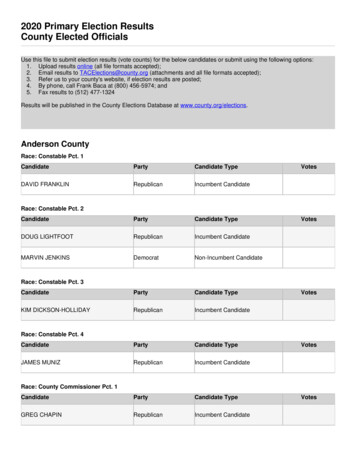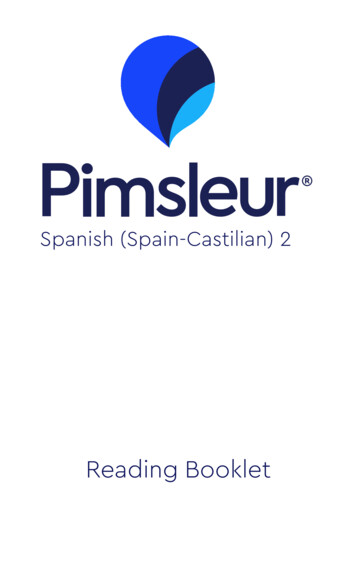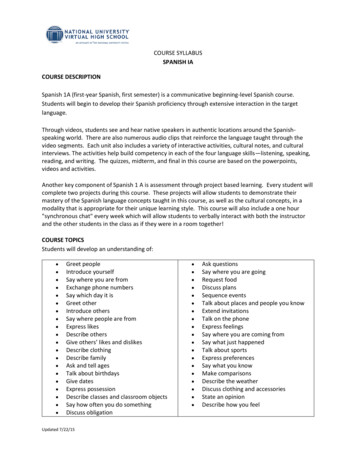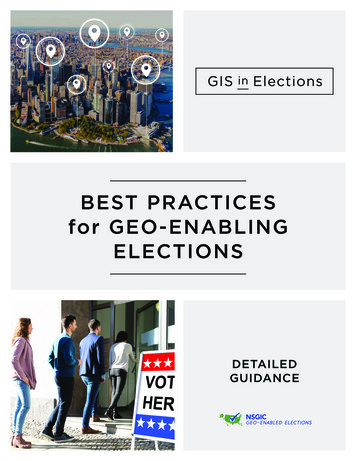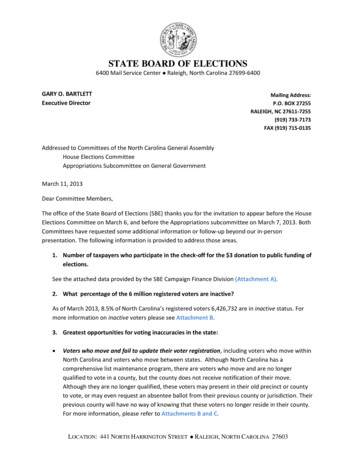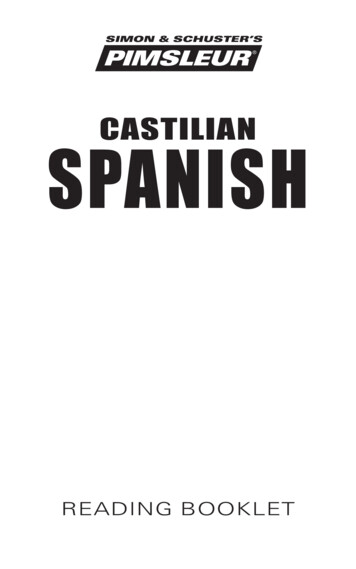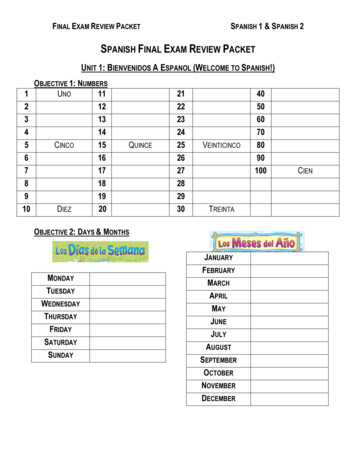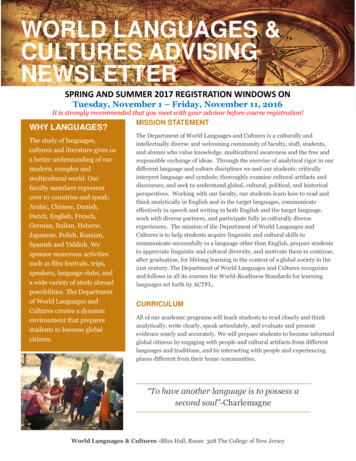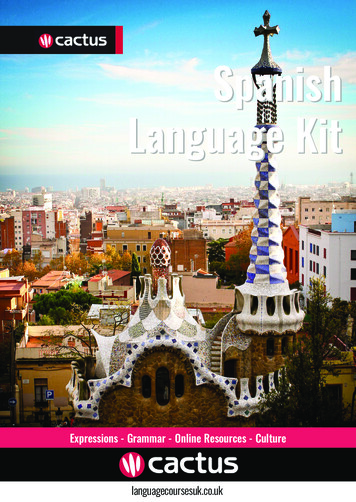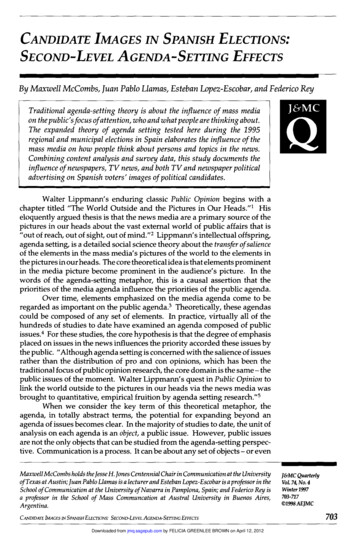
Transcription
CANDIDATE M A G E SIN By Maxwell McCombs, JuanPablo Llamas, Esteban Lopez-Escobar, and Federico ReyTraditional agenda-setting theory is about the injuence of mass mediaon the public‘sfocus ofattention, wkoand what peopleare thinking about.The expanded theory of agenda setting tested here during the 1995regional and municipal elections in Spain elaborates the influence of themass media on how people think about persons and topics in the news.Combining content analysis and survey data, this study documents theinfluence of newspapers, TV news, and both TV and newspaper politicaladvertising on Spanish voters‘ images of political candidates.Walter Lippmann’s enduring classic Public Opinion begins with achapter titled “The World Outside and the Pictures in Our Heads.”’ Hiseloquently argued thesis is that the news media are a primary source of thepictures in our heads about the vast external world of public affairs that is“out of reach, out of sight, out of mind.”2 Lippmann’s intellectualoffspring,agenda setting, is a detailed social sciencetheory about the transfer of salienceof the elements in the mass media’s pictures of the world to the elements inthe pictures in our heads. The core theoretical idea is that elementsprominentin the media picture become prominent in the audience’s picture. In thewords of the agenda-setting metaphor, this is a causal assertion that thepriorities of the media agenda influence the priorities of the public agenda.Over time, elements emphasized on the media agenda come to beregarded as important on the public agenda? Theoretically, these agendascould be composed of any set of elements. In practice, virtually all of thehundreds of studies to date have examined an agenda composed of publici s s e sFor. these studies, the core hypothesis is that the degree of emphasisplaced on issues in the news influences the priority accorded these issues bythe public. “Althoughagenda setting is concerned with the salience of issuesrather than the distribution of pro and con opinions, which has been thetraditional focus of public opinion research, the core domain is the same - thepublic issues of the moment. Walter Lippmann’s quest in Public Opinion tolink the world outside to the pictures in our heads via the news media wasbrought to quantitative, empirical fruition by agenda setting resear h.” When we consider the key term of this theoretical metaphor, theagenda, in totally abstract terms, the potential for expanding beyond anagenda of issues becomes clear. In the majority of studies to date, the unit ofanalysis on each agenda is an object, a public issue. However, public issuesare not the only objects that can be studied from the agenda-setting perspective. Communication is a process. It can be about any set of objects - or evenMaxwellMcCombs holds theJesseH.Jones CentennialChair in Communicationat the Universityof Texas at Austin;Juan Pablo Llamas is a lecturer and Esteban Lopez-Escobar is a professor in theSchool of Communication at the University of Navarra in Pamplona, Spain; and Federico Rey isa professor in the School of Mass Communcation at Austral University in Buenos Aires,Argentina.CANDIDA LMACES IN S P I SELECTIONS.HSECONDLEVELACWDA-SE TINCEFFECTSDownloaded from jmq.sagepub.com by FELICIA GREENLEE BROWN on April 12, 2012j&Mc(2ua,terlyVOZ.74 0 . 4Winter1997703-n701998AEJMC703
a single object - competing for attention among communicators and audiences.Beyond the agenda of objects there also is another level of analysis toconsider. Each of these objects has numerous attributes, those characteristicsand properties that fill out the picture of each object. Just as objects vary insalience, so do the attributes of each object. Both the selection of objects forattention and the selection of attributes for thinking about these objects arepowerful agenda-settingroles. An important part of the news agenda and itsset of objects are the perspectives and frames that journalists and, subsequently, members of the public employ to think about and talk about eachobject. These perspectives and frames draw attention to certain attributesand away from others.One of the strengths of agenda-setting theory that has prompted itscontinuing growth has been its compatibility and complementarity with avariety of other social science concepts and theories, including gatekeeping,status conferral, and the spiral of silence. Discussion of a second level ofagenda setting links the theory to another prominent contemporaryconcept,framing.JamesTankard et al. describe a media frame as "the central organizingidea for news content that supplies a context and suggests what the issue isthrough the use of selection, emphasis, exclusion and elaboration."6 Specificallyin terms of salience, Robert Entman said: "To frame is to select some aspects ofa perceived reality and make them more salient in a communicating text, in such away as to promote a particular problem definition, causal interpretation, moralevaluation andlor treatment recommendationfor the item de cribed." To paraphrase Entman in the language of the second level of agenda setting, framingis the selection of a small number of attributes for inclusion on the mediaagenda when a particular object is discussed. In the context of electioncampaigns, which is the focus of attention in the new research reported here,Patterson has documented the increasing tendency of the American newsmedia to frame political candidates innegative terms! Of course, people alsoframe objects, placing varying degrees of emphasis on the attributes of theseobjects when they are thought about or talked about.How news frames impact the public agenda is the emerging secondlevel of agenda setting. The first level of agenda setting is, of course, thetransmission of object salience. The second level of agenda setting is thetransmission of attribute salience. As this new research frontier broadensour perspective on the agenda-setting role of the news media, BernardCohen's famous dictum about media influence must be revised. In asuccinct summary statement that separated agenda setting from earlierresearch on the effects of mass communication, Cohen noted that while themedia may not tell us what to think, the media are stunningly successful intelling us what to think about.g Explicit attention to the second level ofagenda setting further suggests that the media also tell us how to thinkabout some objects.A quarter century of agenda-setting research has demonstrated thecentrality of news coverage to the focus of public opinion, the agenda ofissues considered paramount by the public. The expanded version of agendasetting presented here, which is grounded in an agenda of attributes definingthe very way we perceive and think about public issues, political candidatesor other topics in the news, assigns the media an even more powerful role inthe political process. Understanding the dynamics of agenda setting iscentral to understanding the dynamics of elections in contemporary democ-704]OURNALIsM E* M A S S COMMUNICmON QUARlTEYDownloaded from jmq.sagepub.com by FELICIA GREENLEE BROWN on April 12, 2012
racies around the world.1 This is a study of these election dynamics in localSpanish elections.Although the popular image of science rests on dramatic discoveries,most social science research is better described as a continuing process inwhichthe implicit gradually becomesexplicit. This processof evolutioniswellillustrated by the emerging elaboration of the second level of agenda settingin a series of recent summary articles,” an elaboration that builds upon earlygeneralizations about the wide range of agenda-setting effects.’* Explicitfocus on this idea of second-levelagenda-settingeffects has prompted a newlook at the accumulated research literature, including several studies fromthe earliest years of agenda-setting research.Two studies from the 1976 U.S. presidential election concisely illustrate the second level of agenda setting. Weaver, Graber, McCombs, andEyal’s13 panel study of the 1976 presidential election found a striking degreeof correspondence between the agenda of attributes in the Chicago Tribuneand the agenda of attributes in Illinois voters’ descriptions of Jimmy Carterand Jerry Ford. The median value of the cross-lagged Spearman’s rhocorrelations between the media agenda and the subsequent public agendawas .70. In the 1976 presidential primaries, Becker and M Combs’ foundconsiderable correspondencebetween the agenda of attributes in Newsweekand the agenda of attributes in New York Democrats’ descriptions of thecontenders for their party’s presidential nomination. Especially compellingin this evidence is that the Spearman’s rho correlations between the twoagendas increased from .64 in mid-February to .83 in late March.Neither of these studies of candidate images during the 1976 presidential election were originally conceptualized in terms of a second level ofagenda setting. But they fit that conceptualization and offer significantevidence that the news media can influence the agenda of attributes thatdefine the pictures of candidates in voters’ minds.Two other studies extend issue salience to the second level by examining the framing of issues. Benton and FrazierI5 presented a detailedanalysis of a recurringmajor issue, the economy. Agenda-settingeffects werefound for newspapers, but not TV news, for two sets of attributes:the specificproblems, causes, and proposed solutions associated with the general topicof the economy (Pearson’s r .81); and the pro and con rationales foreconomic solutions (Pearson’s r .68). CohenI6studied another complexissue in depth, examining six facetsof a local environmental issue in Indiana.He found a strong level of correspondence(Spearman’srho .71)betweenthe picture in people’s minds and local newspaper coverage about thedevelopment of a large, man-made lake.Although all four of these studies offer compelling evidence forsignificant agenda-setting effects on an agenda of attributes, they were notoriginally conceptualized as second-level agenda setting. But considerablenew research has been launched and is beginning to appear. Takeshitaand MikamiI7 found both first- and second-level agenda-setting effectsamong voters in the 1993 Japanese general election. The salience ofelectoral reform, the dominant issue in the news coverage of the election,increased with exposure to both newspapers and television news. Furthermore, at the second level, the salience of structural reforms, which wereemphasized in the news coverage, increased with exposure to both newspapers and television news while the salience of regulatory reform, which waslow on the media agenda, showed no correlation with level of exposure to thenews.C A N D I D G EE I NSSPANISH ELECTTONS SECONDLEVEL AGENDA-SETTING EFFECTSDownloaded from jmq.sagepub.com by FELICIA GREENLEE BROWN on April 12, 2012705
In a setting akin to this study from Spain, Kingla examined theinfluence of three major newspapers on voters’ images of the three candidates for mayor of Taipei in 1994. All six Spearman’s rho correlations of thevoters’ images with the agenda of attributes in two major newspapers weresignificant. These six significant correlations( 3 candidates x 2 newspapers)ranged from .59 to .75. The median value was .68. None of thecorrelations with the smaller opposition newspaper were significant.Outside the election tradition of agenda setting, Ghanem and EvattI9found that public concern among Texans about crime over a three-yearperiod was strongly linked (Spearman’s rho .70) to the pattern of newscoverage in the state’s major newspapers. There also was evidence thatspecific frames in the crime coverage prompted public concern about crime.For example, news stories depicting psychologicallyclose situations- crimesoccurring locally or situations in which the average person might feelendangered - produced effects equivalentin strength to traditional first-levelagenda-setting effects based on total news coverage of crime.Second-LevelHypothesesThe present study, conducted in the northern province of Navarraduring the 1995 Spanish regional and municipal elections, focused directlyon the second level of agenda setting, specifically the relationship betweenthe images of the candidates presented in the mass media and the images ofthe candidates among voters in Pamplona, the capital city of Navarra. Justas a painter draws colors and forms from reality to create a representationthatis no longer reality itself, but an image of it, the news media select attributesof candidates to construct images appropriate to news stories about theelection while the political parties select attributes of the candidates toconstruct images in their political advertising aimed at winning votes.These constructed images are a major source of learning about thecandidates among voters, which is to say that the agenda-setting process atthe second level is a key aspect of the electoral process. This new research onsecond-level agenda-settingeffects is needed to broaden our understandingof the political process in modern democracies. It shows that the role playedby the media is not restrained to the setting of social priorities (a first-levelagenda of issues),but extends as well to the selection of the specific features(or attributes) of the candidates from which voters will shape their ownopinions about those candidates. The media may not dictate to voters whattheir opinion will be about political candidates, but they may well direct,guide, or orient the content of what the public deems worthy of saying aboutthem to a significant degree.The attributes forming the images of the candidates can be analyzedin terms of both a substantive dimension and an affectivedimension. Specifically in terms of second-levelagenda-settingeffects, this study hypothesized:The agenda of substantive attributes of candidates (e.g.,descriptions of their personality, their stands on issues, etc.)presented in the mass media influences the agenda of substantive attributes defining the images of the candidates amongvoters.The agenda of affective attributes of candidates (e.g.,positive, negative, and neutral descriptions)presented in themass media influences the agenda of affectiveattributes defining the images of the candidates among voters.706 JURNAUSM& MASSCOMMUNICATIONQUARTERLYDownloaded from jmq.sagepub.com by FELICIA GREENLEE BROWN on April 12, 2012
No genre hypothesis is offered here about the relative influence of the newsmedia and political advertising, but this question will be pursued in theanalysis. Similarly, no medium of communication hypothesis is offered aboutthe relative influence of newspapers and television news or the relativeinfluence of the TV ads and the newspaper advertising. Again, this questionwill be pursued in the analysis.To test these hypotheses, we examined the images of the candidatesfor mayor of Pamplona and leader of the Navarra parliament put forwardby the five major political parties: UPN (Union of the Navarran People,which represents the right wing); CDN (Convergence of Navarran Democrats, a new political party which had just split off from UPN); PSN (SocialistParty of Navarra, an affiliate of PSOE, the Spanish Workers SocialistParty offormer Prime MinisterFelipeGonzalez);IU (the United Left, a coalition of theSpanish Communist Party and other minor left wing organizations, such asthe Party of the Greens);and HB (Herri Batasuna, a Basque nationalist partywith an extreme left-wing ideology).Data on the candidates’ images from a voter survey and from acontent analysis of the mass media were organized according to two dimensions: (1)a substantive dimension defined by three categories, the candidates’ideology and positions on public issues, their qualificationsandexperience, and theirpersonal characteristics and personality; and (2) an affective dimension wherethe candidates were described in positive, negative, or neutral terms.Election day was 28 May 1995and immediately afterward, 1-5June, atelephone survey was conducted among voters in the city of Pamplona. Aseries of open-ended questions elicited descriptions for each of the fiveparties’ candidates for mayor and leader of parliament: “Imagine that you hadafriend who didn’t know anything about the candidates (for the Parliament or formayor). What would you tell yourfriendabout . (the name of each candidate forthe Parliament or for mayor)?” Interviews lasting around ten minutes werecompleted with 299 randomly selected Pamplona voters. The reponse ratefor the survey was 60.8%. The balance, 39.2%,consists of refusals and personsnot at home.20To determine the images of the candidates presented by the massmedia, a content analysis examined the two local daily newspapers, Diario deNavarra and Diario de Noticias, and the major regional television newsprogram, Telenavarra,which is a program of TV 1,one of the two channels ofSpanish national television. The content analysis also examined politicaladvertising in the newspapers and on TV. Identical coding procedures wereused for the news and political advertising content of the newspapers andtelevision. As the campaign period was quite short, only fifteen days in all,followed by a “day of reflection” and then election day, the content analysisis based on all the relevant newspaper and television content from 12May to26 May. By positioning the voter survey after the full fifteen-day campaignperiod, the study can examine the full impact of the news and advertising inthe mass media during this short campaign period.Ten coders carried out the content analysis of the data. They were allfamiliar with the current political environment in Navarra, but none of themis a member, activist, or supporter of a specific political party or politicalposition. Every news story appearing in the media under study during theentire campaign period whose headline made either a direct or indirectCANDIDATE GE INSSPANISHELECTIONS SECONDLEVELAGENDA-SETTINGEFFECTSDownloaded from jmq.sagepub.com by FELICIA GREENLEE BROWN on April 12, 2012DataCozZection707
reference to the candidates or the campaign was examined. All the politicalads on TV and in the newspapers also were examined. The unit of analysiswas the individual statement about the candidate.The coders were familiar with the tone and language used by thevoters in their descriptions of the candidates. Prior to the content analysis,each coder had reviewed all of the survey responses to the questions aboutthe candidates' images. Each coder was provided with a list of possibleexpressionsto be found in the description of each candidate, which had beencompiled from analysis of the survey responses and a more general, abstractdiscussion of candidate images prior to any analysis of the data. This listcontained detailed instructions on how to codifiy these expressions in termsof the three categories of the substantive dimension and the three categoriesof the affective dimension.The substantive dimension referred to:(1)Ideology and issue positions. This category includesall statements in which candidates were portrayed as "leftwing," "right-wing," or "center," and all the statements expressing the position of candidates on specific issues.(2)Qualifications and experience. This category includesall statements about the competency of the candidates foroffice, their previous experience in government posts, andbiographical details of the candidates.(3) Personality. This category includes all personal traitsand features of the character of the candidates, including theirmoral standing, their charisma, their natural intelligence,theircourage, ambition, independence, and so on.All of these statements also were codified in terms of positive, neutral,or negative affect. Taking into account the difficulty of avoiding biaseswhen undertaking the coding of affective attributes, we prepared a detailedset of instructions for this part of the content analysis. The first step was todefine all those statements that can bluntly be regarded as positive ornegative by the average person: for example, "honest" vs. "corrupt," or"supporter of the terrorists." Next were added some commonly usedpejorative words. For example, in Spain "derechona" is a negative way ofreferring to the "derecha" (right-wing) and "sociata" carries a negativenuance about the socialists.The coding also paid attention to the meaning of statements inaccordance with their context. For example, the expression "he is a leftist"said by a political adversary has a negative meaning, while it can be considered neutral when found in factual information. Similarly,the expression "heis right-wing" abaout a candidate who has made a point of being "center"would be regarded as negative.Coders were instructed not to interpret any possible underlyingmeaning in the statements found in the media. Any adjective or expressionreferring to a candidate that would not explicitlyfavor or harm the candidatewas coded as neutral.A trial run to measure the degree of correspondenceamong the codersin their analysis of the mass media material yielded a median Pearson's r of .91.708JOURNAIISM & MASSCOMMUNICAIONQWERLYDownloaded from jmq.sagepub.com by FELICIA GREENLEE BROWN on April 12, 2012
Comparisons of the distributions of these substantive and affectiveattributes in the various mass media messages with the voters’ surveyresponses will reveal how much the style of the voters’ descriptions followsthe style of the mass media in describing political candidates. Two sets ofcomparisons were carried out for each hypothesis, one set based on theimages of the parliamentary candidates, the other based on images of thecandidates for mayor. For the first hypothesis about the influence of themedia agenda of substantive attributes on the public, each of these setsconsisted of five comparisons: images among the public compared with(1) the television political ads, (2) political advertising in the newspaper, (3)TV news, and (4-5) news stories in two Pamplona newspapers.For the second hypothesis about the influence of the media agenda ofaffective attributes on the public, each of the sets consisted of three comparisons: images among the public compared with (1) TV news and (2-3) newsstoriesin two Pamplona newspapers. Political advertising was not includedbecause there was no negative advertising about the candidates.Correlation statisticswill be calculated for each of the sixteen comparisons just described as tests of the two hypotheses. Because this is one of thefirst studies to explore second-levelagenda-setting effects, the analyseshereare limited to establishing the existence of significant correlations betweenthe content of the mass media during the formal election campaign and theimages held by voters at the end of the campaign. Obviously, this is not thetotal array of evidence needed to establish causality, but the existence ofsignificant correlations between the media and public agendas of attributesis a necessary condition for the survival of the theory. Seeking corroboratoryevidence of this necessary condition is the research strategy here. In theabsence of any correlations, the theory would be falsified and rejected. Thepresence of significantcorrelationswill lay the foundation for future researchwith more complex research designs.DataAnalysisBy way of preface, on every mass media agenda examined in thecontent analysis and on the public agenda determined by the voter survey,mentions of the candidates for the Navarra parliament are far more numerous than mentions of the candidates for mayor of Pamplona. In Table 1, theratios favoring the parliamentary candidates over the mayoral candidatesrange from a low of 3 to 1 in television news to a high of 15 to 1 in the TVpolitical ads. On the public agenda, the ratio is only about 1.5 to 1, but stillthe difference is substantial.The first two agendas listed in Table 1 are those controlled by theparties themselves, the ads placed on television and the paid political ads runin the newspapers. In all of these ads the parties concentrated overwhelmingly on the parliamentary candidates. Only 6% of the ads in both scheduleswere about the mayoral candidates. Even when the ads mentioning candidates for both offices (23.8%of the newspaper ads, but none of the TV ads)aretaken into account, less than a third of the party-produced newspaper adsfocused on the race for mayor.The ratios of attention are smaller on the agendas constructed byjournalists, both for TV news and newspapers, but again the gap in attentionis considerable, especially in the newspapers. This differential level ofattention also is reflected on the public agenda, albeit to a lesser degree. Thevoter survey asked specificallyabout each of the five candidates for leader ofSubstantiveandAflectiveAgendasCANDIDAEh TSDownloaded from jmq.sagepub.com by FELICIA GREENLEE BROWN on April 12, 2012709
TABLE 2Mentions of the Candidatesfor Parliament and Mayorby the Media and Pamplona VotersAgendaParliamentMayorBothYoYoYo23.9TV Advertising (n 3058)Newspaper Advertising (n 104)93.969.36.16.8TV News (n 12,957)Newspaper Stories (n 354)76.885.323.214.7Voter Survey (n 2054)58.241.8Note: The number of mentions for the TV ads and news stories is measured by the number of secondsdevoted to descriptions of the candidates. Due to the extreme variability of the formats for the print adsand news stories, the number of mentions is based on the number of ads or news stories in which thecandidates were mentioned. For the voters, the number of mentions is based on the total number ofdescriptive statements made by respondents about the candidates.parliament and each of the five candidates for mayor. Under this methodicalquestioning, 58.2%of all the responses are reasonably detailed descriptionsof the parliamentary candidates. Only 41.8% of all the candidates descriptions are about the mayoral candidates. This is a higher percentage ofmentions among the public than on any of the mass media agendas, mostlikely prompted by the very design of the questionnaire that gave equalweight to the candidates for both offices. Respondents may have feltcompelled to say something about the mayoral candidates,but, nevertheless,like the mass media, they had less to say.Turning to the specific style of these descriptions of the candidates,Table 2 displays the substantive attribute agendas for both the parliamentaryand mayoral candidates in the various mass media and among Pamplonavoters. Although the relative emphasis on qualifications, personality, andideology differs substantially across the agendas, there are two distinctpatterns.One is a medium of communicationpattern. The television advertisingand television news stories are very similar in their heavy emphasis on thecandidates’ qualifications. This emphasis is true for both parliamentary andmayoral candidates. The newspapers differ from television in their emphasis, but within the newspapers both the advertising and the news stories arealike in their emphasis on ideology. This is true for both the parliamentaryand mayoral candidates.This consistency across the two genres, news and advertising, withina medium, but the differencebetween the two media, television and newspapers, means that there is nogenre pattern. The substantive attribute agendasof television and newspaper advertising are different. The substantiveattribute agendas of newspaper and television journalism are different.There also is a voter pattern in Table 2. The voters are highly consistentin the kinds of attributes emphasized in their descriptions of the parliamentary and mayoral candidates. They also differ substantiallyfrom all the massmedia in their emphasis on personality.710JOURNAUSM 6. MASSC O M M U N I C QUARTERLYIONDownloaded from jmq.sagepub.com by FELICIA GREENLEE BROWN on April 12, 2012
TABLE 2Emphasis on the Substantive Attributes of the Candidatesfor Parliament and Mayorby the Various Mass Media and Pamplona VotersQualificationsPersonalityIdeology%%%TV AdvertisingParliament (n 2,871)Mayor (n 187)55.398.40.11.644.5Newspaper AdvertisingParliament (n 94)Mayor (n ewspaper StoriesParliament (n 302)Mayor (n 52)27.228.832.126.940.744.2Pamplona VotersParliament (n 1,195)Mayor (n 859)19.724.968.060.412.314.7TV NewsParliament (n 8,616)Mayor (n 2,601)Note: The number of mentions for the TV ads and news stories is measured by the number of secondsdevoted to substantive descriptions of the candidates. Due to the extreme variability of the formats forthe print ads and news stories, the number of mentions is based on the number of ads or news storiesin which substantive attributes of the candidates were mentioned.Shifting to the affective dimension of the descriptions of the candidates, Table 3 shows that positive descriptions prevailed over negativedescriptions in all the news coverage. This is especially the situation intelevision news. Although positive outweighs negative in the newspaper aswell, more than a third of the candidate descriptions in newspaper storieswere negative because the newspaper stories allowed the candidates to speakabout each other. This negative attention primarily centered on the twoconservative parties, UPN and CDN, which had recently split off from theUPN. These were also the parties most frequently mentioned in the newspaper, accounting for nearly three-fourths of the total coverage. For UPN, 45.8%of the coverage was negative. For CDN, 43.4% of the coverage was negative.For the other eight parties combined, about 10.0% of the coverage wasnegative. As previously noted, there were no negative descriptions in thepolitical ads, and they are omitted from the table. There also is a high degreeof consistency within each news medium in the
trate the second level of agenda setting. Weaver, Graber, McCombs, and Eyal's13 panel study of the 1976 presidential election found a striking degree of correspondence between the agenda of attributes in the Chicago Tribune and the agenda of attributes in Illinois voters' descriptions of Jimmy Carter and Jerry Ford.
